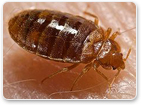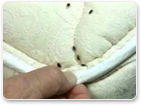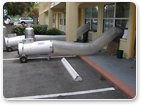Bed Bugs Facts, Prevention, Treatment and Total Extermination
FREQUENTLY Asked Questions
What are bed bugs?
Bed bugs are small parasitic insects that prefer to feed on human blood. Adult bed bugs are brown, oval-shaped, and approximately 1/4 inch long.
What can bed bugs to do me?

Bed bugs typically feed on their host (which may be you) at night, though if hungry they can feed during daylight hours as well. A bed bug feeds by penetrating the skin and drawing blood. The result is often manifested as red, itchy welts.
Although there are no immediate serious health threats from bed bug bites, their most common psychological effects include insomnia, depression, irritability and restlessness, and in severe cases, psychosis.
Aside from the psychological effects, a bed bug infestation carries social and economic repercussions. A business marked as infested will very seriously deter clientele. In the home, the same goes for guests and friends, as bed bugs could easily follow them home after a visit to you.
What do bed bug bites look like?
Most commonly, bites are large, itchy, red welts. However, there are many exceptions. Some individuals do not react at all; others react mildly or weeks later; still others react severely.
When do bed bugs usually feed?
If you’ve ever heard the nursery rhyme, “good night, sleep tight, don’t let the bed bugs bite,” you probably know that these critters feed at night. Typically, biting happens about an hour before dawn. However, if hungry, bed bugs will feed any time of the day. The normal feeding frequency for a bed bug is roughly once every five to ten days. However, they can survive for up to a year with no food.
Where did bed bugs come from?

The last known bed bug epidemic in the United States occurred in the 1950s prior to the introduction of DDT, which quickly wiped most infestations off the map. In the following decades, bed bugs were virtually unheard of in the US.
However, as foreign travel increased in the 1990s, bed bugs returned, arriving in people’s luggage and clothing. Since, for public health reasons, DDT is no longer used, infestations now occur regularly in this country.
Are bed bugs only a problem for those living in poverty?
No. This is a common misconception. Households of all socioeconomic backgrounds get bed bugs.
Where do bed bugs hide?
Bed bugs do not discriminate. They do not care if you are messy or clean. If there is blood, they are happy. Any place with a high turnover of people is at risk (apartment buildings, schools, hotels, movie theaters, etc.)
In the home, bed bugs are most likely to reside within a few feet of where you sleep. They are typically found in crevices, seams, headboards, and nearby furniture. Although clutter does not cause infestations, it does make them more difficult to get rid of, since there are more places for the bed bugs to hide.
I have bed bugs! What do I do now?
First, take a deep breath and don’t panic. There is a solution.
Next, make a plan.
This is where we come in. We will help you to get rid of bed bugs quickly and without toxic insecticides, and we will help you to create a preventive maintenance plan to prevent future infestations.
How did I come to have bed bugs in the first place?
Most often, bed bugs enter a home or business via luggage, clothing, visitors, used furniture, or a child’s backpack.
How long does it take to get rid of bed bugs?
The answer depends on the type of treatment your select.
Our value or budget packages usually involve the use of insecticide dust, involve thorough preparation, and take up to three treatments before the problem is fully resolved.
Our thermo remediation treatment eliminates bed bugs and their eggs over a 6-8 hour period and requires only one treatment.
In either case, the results will depend on cooperation between you and the pest control professional.
Are heat treatments safe?
When properly performed by trained technicians, structural heating is safe. Pest-Heat™ technology has been applied successfully in tens of thousands of homes and commercial properties throughout the United States. In addition to exterminating bed bugs, structural heat treatments also kill bacteria, viruses, mold, fungi, and can even eliminate some allergens and long-standing odors.
Why is heat effective?

There are two main reasons why heat works against bed bugs.
First, as a bed bug’s skeleton is 60% water, dehydration due to heat quickly causes it to become paralyzed and die.
Second, bed bugs are naturally attracted to heat because it indicates the presence of a food source. During the heating process, they will come out of their hiding places in search of food. Because of the elevated temperature, they will quickly become too weak to retreat back into their hiding spots, get dehydrated, and die.
To ensure complete penetration of the structure, we use heat probes, eliminating the need to throw out and replace expensive possessions.
I’ve seen ads for a do-it-yourself product. Wouldn’t it be cheaper to get rid of the bed bugs myself?
No.
First of all, these treatments are not effective. According to a recent survey conducted by the National Pest Management Association, bed bugs ranked as the most difficult pest to eliminate among 76% of pest control professionals, way above termites, ants, or cockroaches. The majority of do-it-yourself sprays and “bombs” contain chemicals to which most bed bugs are already resistant. Further, the sprays typically cause bed bugs to flee the area they are in and spread to another area – possibly all over your home.
Second, do-it-yourself treatments can be damaging to your belongings and hazardous to your health. Irresponsible use of pesticides by homeowners has previously resulted in injury and even death.
Please, always consult a trained professional when dealing with bed bugs.
What should a pest control company do for me?
Your pest control professional should be knowledgeable about bed bugs and aware of why thorough preparation is important in eradicating them. If your company does not require prep work, consider hiring someone else. If you need help preparing, ask us for a quote.
A thorough pest control professional may ask you to wash all clothing, bedding, and draperies. You may also be asked to purchase resealable bags for all possessions in closets and drawers. Bed preparation may also be required.
Always make sure that you understand the reasons behind your pest control professional’s requests and procedures.
Why do I need a follow-up treatment?
When using non-heat treatment methods, unhatched bed bug eggs are not being penetrated. Because they take two or three weeks to hatch, additional treatments are required. For each successive treatment, thorough preparation is just as vital as for the first (as always, we’re here to help you if needed).

